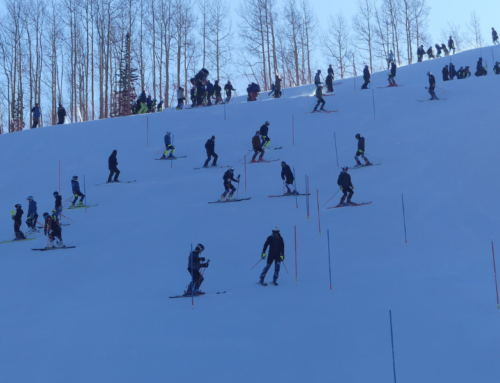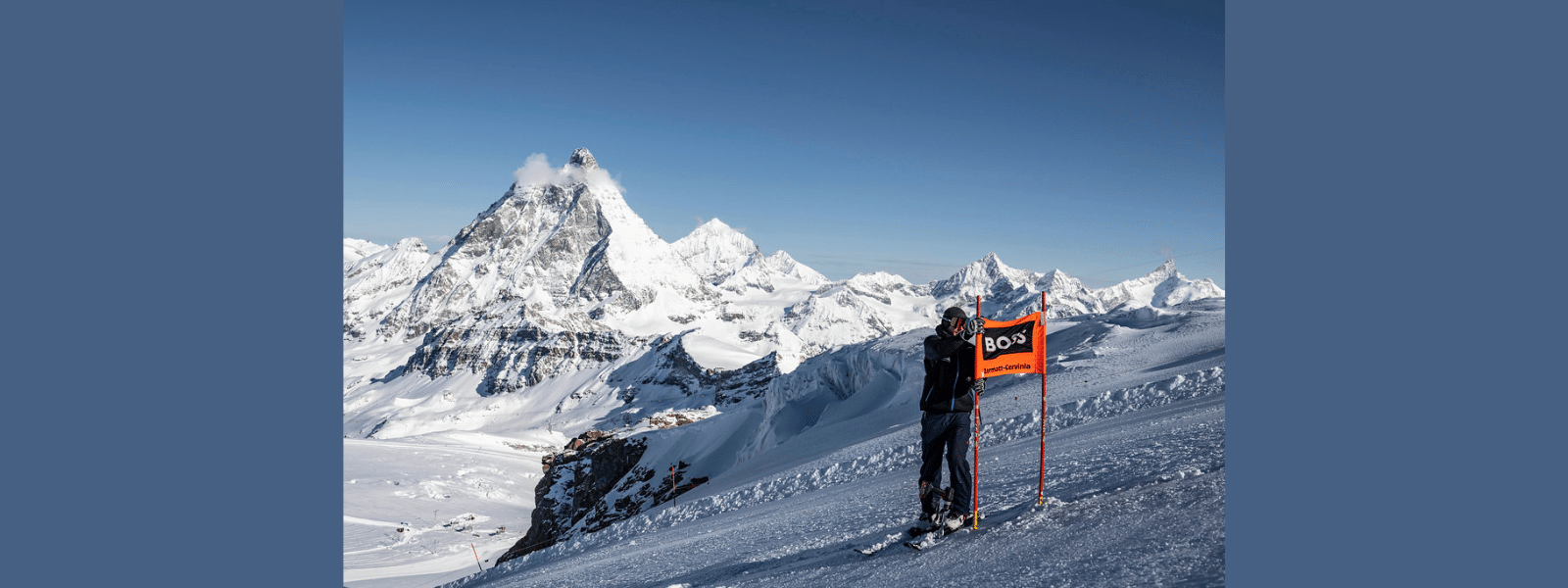Coaches Ed Online: Eat right, race better
No. 1 nutrition tip for alpine ski competition — and guys, there is just no excuse not to do this — pee in the snow and check the color. If it’s dark yellow, you need more water. Gals, sorry, it’s a little more complicated, but the advice holds true.
 NO. 1 NUTRITION tip for alpine ski competition — and guys, there is just no excuse not to do this — pee in the snow and check the color. If it’s dark yellow, you need more water. Gals, sorry, it’s a little more complicated, but the advice holds true.
NO. 1 NUTRITION tip for alpine ski competition — and guys, there is just no excuse not to do this — pee in the snow and check the color. If it’s dark yellow, you need more water. Gals, sorry, it’s a little more complicated, but the advice holds true.
No. 1 tip for getting through this entire article: Keep reading.
It is possible the choice of author for a piece on nutrition in skiing was not among the top 10, so it is important to realize none of the advice herein comes from the author. Billions of electrons were employed in obtaining this information, and most of them were not rearranged much.
According to a paper published by Susie Parker-Simmons, Sue Robson and Andy Walshe with the U.S. Ski Team, alpine racing requires optimal fuel supply for peak performance, withstanding training loads and the physiological adaptations required during dryland conditioning.
The intermittent high-intensity of skiing calls for anaerobic energy sources that result in substantial lactate accumulation. Depletion of glycogen, the primary source of energy in skiing, is the outcome.
Who knew?
Apparently, nutrition in sports has been the subject of a great deal of study. It’s been science-tized and popularized. And, thanks largely to those good folks we mentioned earlier, it has even been sport specificized.
More from the Parker-Simmons/Robson/Walshe paper: Among the energy problems to be overcome are elevation and cold temperatures. Training and competing at altitude and in the cold weather results in a compounding of environmental stress and metabolic challenges that carry a number of nutritional implications.
According to the paper: Specific physiological responses and limitations occur in athletes at altitude. Carbohydrate utilization is enhanced, fat utilization is reduced, calorie and fluid requirements increase while appetite is suppressed. Ferritin levels should be adequate before an athlete trains or competes at altitude as synthesis of new red blood cells will not occur adequately in iron-deficient athletes.
Not speculation, but proven fact: At altitude, the nervous system kicks into high gear, taking the rest of the body with it.
It has been shown that this hypoxia-induced rise in catecholamines is both acute and chronic, with the main objective to preserve blood flow and oxygen delivery to tissues and organs. The acute rise in epinephrine results in changes in heart rate, stroke volume and cardiac output. Norepinephrine’s rise occurs later, peaking by day seven at altitude and remaining elevated through the course of exposure. The elevation of norepinephrine leads to an increase in ventilation, vasoconstriction, as well as blood and vascular pressure.
Which all seems to mean it takes more energy to work in the cold and at altitude.
The Position of Dietitians of Canada, the American Dietetic Association and the American College of Sports Medicine says that: “There is no doubt that what an athlete eats and drinks can affect health, body weight and composition, substrate availability during exercise, recovery time after exercise and ultimately, exercise performance.”
The position also says: Dehydration decreases exercise performance; thus adequate fluid intake before, during and after exercise is necessary for health and optimal performance.
See, what did we tell you?
Here’s what Parker-Simmons — perhaps the foremost sports nutritionist out there — considers important: The most important nutritional factors to consider when working with winter sport athletes are the cumulative effect of cold and altitude that may lead to increased energy expenditure, greater reliance on blood glucose and muscle glycogen, and exacerbated fluid loss.
She continues: It has previously been demonstrated that fuel selection at high altitude shifts to a greater use of blood glucose for men both at rest and during exercise compared to sea level. Also it has been shown that carbohydrate oxidation may be elevated up to six-fold during shivering thermogenesis. This rise in carbohydrate oxidation is provided by greater plasma glucose turnover, muscle glycolysis, as well as glycogenolysis. … Due to the large anaerobic contribution to alpine and freestyle skiing performance, a high rate of glycogen utilization is likely to occur during a day of intense ski training. Glycogen stores can be reduced to 50 percent of initial value after a typical day of training for skiing.
This explains that hunger we get when skiing. Wonder what other explanations might be out there?
Chris Carmichael advises, among others, Lance Armstrong on nutrition. Among his basic principle is that intake should fluctuate along with levels of physical activity. He is also critical of diets in general, which puts him in good stead with the author. “We may have lost weight, but have we achieved better health?” is the question he puts forth.
“A lot of low-carb diets have wreaked havoc on active people who are trying to keep up with that diet. They don’t have the carbohydrates to handle the exercise they’re used to doing. They go out and try to do a triathlon or something, and they can’t make it. They’ve depleted their glycogen stores so much.”
Carmichael says among the best things athletes can do is to get an understanding of how food affects the body and energy levels, and also says not to let the diet get static. Food — his words not mine — should be dynamic and fluctuate. I’m liking this guy.
The third thing would be to look at food by category. Is what you eat a “quality carrier” food (spinach, whole-grain cereal and other foods high in vitamins and minerals), “empty carrier” (minimally nutritious fare such as soda, white rice and pretzels) or "pollutant carrier" (french fries, doughnuts and other goodies high in calories and fat)?
Damn. Pollutant carriers. The man can turn a phrase though, got to give him that.
The U.S. Ski has bought into the whole sports science spectrum, and the nutrition side in particular, it being an area which can be affected quite easily.
“Most teenagers are into junk food,” said Parker-Simmons. “The athlete cannot afford to do so. Parents should send the athlete to training with a full tank,” which, she said, should include an emergency food kit with trail mix, crackers, cheese, juice and such.
This summer, the team had Kaylin Richardson and Lindsey Kildow talk about why. As usual, the athlete take on it is simple and pure: “At the end of the season, when I’m most tired, I need to be able to race at 110 percent and not get hurt,” said Kildow.
“Keeping healthy and away from injury is what this is all about,” said Richardson. “Maintaining your core strength throughout the season will help. … To win a race, you have to ski those last four gates with as much energy as the first four.”
That’s easy to buy.
Speaking of buying, the U.S. S
ki Team’s Elite Performance DVD’s — check out the USSA Web site Coaches Ed page — can give the reader all the basics, though like much of this stuff, it’s deadly dull until you get to the actual implementation.
And, while there is a proliferation of sports nutrition info out there, it comes with some warnings attached.
Patti Steimuller, a sports nutrition instructor at Montana State University at Bozeman in her regular life, suggests: “Nutrition for performance enhancement is a hot topic and everyone wants part of the action. … Taking one nutrition course, attending a workshop, reading a nutrition article or working in the dietary supplement industry is enough to convince some individuals that they are qualified to offer sports nutrition services.”
So don’t believe everything you hear or read. But do find out what you want to know. This stuff makes a difference.
Oh, and Wake Forest medical center did a study on the nutritional value of fast-food chains. Check it out.
→ See issue 7 of Ski Racing magazine for Bill McCollom's Parenting column: "Low-carb? No chance"
Coaches Ed Q&A
With Finn Gundersen
 Question: Help, I’m a worried parent. There’s no snow and no open ski area. Is my J2 daughter’s ski career over?
Question: Help, I’m a worried parent. There’s no snow and no open ski area. Is my J2 daughter’s ski career over?
Finn Gundersen: No, losing weeks or even months of skiing is not the end of the world. Suffering a season-ending injury is far worse than the slow start Europe, the Midwest and East is currently experiencing. Make the best of a bad situation by watching more video! By that, I mean doing both technical and tactical analytical work with a coach, while also spending time alone, just your J2 daughter watching World Cup winning runs by the hour. Visual imaging is a powerful tool, one not to be underestimated, but it needs to be trained. Next, whatever patch of snow is available use it, even if it requires hiking. The Cochran dynasty is testament to what can be accomplished on a very SMALL hill, often with limited conditions. A creative coach well-schooled in fundamental skill work can still accomplish critical skill work. Push your coach to use what snow there is or plan to travel as needed. If global warming is happening, then we had better be ready for some lean years ahead.
Finally, there is no substitute for doing a little extra physical conditioning, including lots of coordination, agility and balance work. A well-planned dryland training program can contribute to dramatic changes when your daughter returns to snow. Every coach has countless examples of athletes who have made incredible skiing progress after a summer of conditioning while also participating in a wide variety of other sports, because of simply growing as an athlete. Keep the faith, winter is on the way and be ready to ski way into late March and early April.
Finn Gundersen is USSA’s director of alpine education. Send questions to info@skiracing.com with the subject line FINN QUESTION.





















